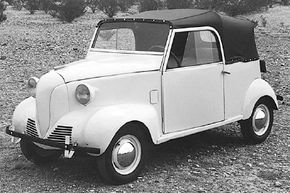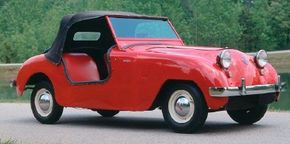Powel Crosley, Jr., built one crude small car while a teenager at the turn of the century, then became a radio and refrigerator magnate in the '20s and '30s. But cars remained his first love, and in 1939 he entered the auto business in a big way with a very small product.
Dreaming of an American "volkswagen," he offered a tiny 80-inch-wheelbase two-cylinder job at the lowest price in the land: $325-$350. Measuring just 10 feet long and weighing less than half a ton, it garnered a modest 2017 sales for '39.
Advertisement
To buy one, you visited a local hardware store or appliance shop -- a novel but shortsighted marketing scheme. Crosley Motors built about 5000 cars by 1942, when the government halted civilian production for the duration of World War II.
There were just two Crosley models for 1939: a two-passenger convertible coupe and a four-passenger convertible sedan. Prices dropped as low as $299 for 1940, when offerings expanded to include standard and DeLuxe convertible sedans, a convertible coupe, a wood-body station wagon, a "covered wagon" with full canvas top, and several commercial types.
Styling was little changed and very basic, dominated by low, freestanding fenders and a prominent hood bulged out ahead of small horizontal grilles in the front apron. Headlamps attached to the sides of the hood. Interiors were barren -- just a central speedometer flanked by fuel and water gauges.
Crosley power through 1942 came from an air-cooled, two-main-bearing Waukesha twin producing 131/2 horsepower from 38.9 cubic inches. Performance wasn't quite as bad as those figures imply, since gearing was ultralow. Top speed was about 50 miles an hour, though the factory recommended cruising at no more than 40. Crosley claimed up to 60 miles per gallon, though few owners likely exceeded 50 mpg.
Completing this bare-bones package were unsynchronized three-speed gearbox, cable-operated mechanical brakes, six-gallon fuel tank, sliding (instead of roll-down) door windows, a single hand-operated windshield wiper, and petite 4.25212-inch tires on simple disc wheels.
The customary universal joints were eliminated as a further cost-cutting measure, flexible rubber engine mounts supposedly making them unnecessary. But they were necessary, as owners found out. They also discovered that Crosley dealers were far better equipped to fix refrigerators than cars. With this, 1940 volume fell by more than three-fourths despite the expanded lineup.
To fix things up for '41, Crosley called in engineer Paul Klotsch, late of the Briggs Manufacturing Company. Klotsch redesigned the motor mounts, added U-joints to the driveshaft, revised the lubrication system, shortened the stroke, and increased main-bearing surface area -- the last two to improve engine durability.
The revised engine ended up at 35.3 cid and 12 horsepower, but it powered a greatly improved Crosley and sales went up -- to 2289 -- despite higher prices ($339-$496). The cars were now sold through separate automobile dealers in addition to Crosley's appliance outlets. There were no technical changes for '42, but prices rose again (to $468-$582) and the "covered wagon" was dropped. Crosley built 1029 cars that war-shortened model year.
For more on defunct American cars, see:
- AMC
- Duesenberg
- Oldsmobile
- Plymouth
- Studebaker
- Tucker
Advertisement

